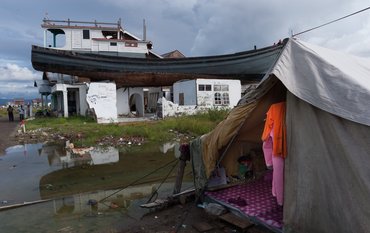First analyses of satellite and GEOFON data give insights into the processes around the Herat fault, a region that is considered to be seismically rather inactive.
Update: 16. October 2023)
A series of major earthquakes has shaken northwestern Afghanistan, a region where so far no large quakes have been detected. On Saturday, October 7, two destructive earthquakes occurred ~30 km NW of the Afghan town Herat with magnitudes of 6.2 and 6.3 (geofon.gfz-potsdam.de), at 11:11 am and 11:43 am local time in Afghanistan (6:41 and 7:13 UTC) and at a depth of only about 10 km. Earthquakes at such shallow depths can have particularly devastating effects.
Herat is the second largest city in the country after Kabul. Local agencies claim at least 2000 casualties (dpa, ZEIT), and thousands more injured people. According to the WHO at least 600 houses in thirteen Afghan villages were destroyed.
In the early morning of 11 October at 5:11 a.m. local time (0:41 UTC), the third strong quake within a few days occurred about 10 kilometres west of the previous epicentres, and a fourth on 15 October at 8:06 a.m. local time (3:36 UTC) north of Herat, both with a magnitude of 6.3 at a depth of about 10 kilometres.
First major earthquakes in this region for centuries
These were the first large earthquakes (M > 4,5) which have been detected in that region since official data are available at around 1900. In contrast to the east of the country which regularly experiences larger quakes – most recently last summer, the northwest is considered seismically largely inactive: There are no historical proofs of similarly devastating events in the region for centuries.
More aftershocks to be expected
In addition to the main shocks, the GEOFON monitoring service detected 20 aftershocks with M ≥ 4.3 so far (16.10., 17:40 UTC), 12 of them in the first two days after the first event. In addition, many smaller earthquakes could have been felt in the area. Seismic activity can be expected to remain elevated for at least several weeks.
Rupture in the Herat Fault System
Our preliminary analysis of seismic and satellite-geodetic data (radar satellite interferometry, InSAR) reveal that the earthquakes ruptured a 10-20 km-long western segment of the ~700 km-long Herat fault system that traverses the Hindu Kush Mountain range from West to East. And the region around the epicentre has risen by about 40 cm in an area of about 20 km x 30 km.
The Hindu Kush is part of the Alpine-Himalayan Mountain belt and located to the west of the Himalayan Mountain range. It has been built by the pressures exerted due to the Indian plate bulldozing northward into the Eurasian plate.
Analysis of the four main shocks suggests that these earthquakes are thrust events with approximately east-west strikes, which accommodate north-south shortening.
Need for further scientific studies on the region – though with only sparse observational opportunities available
The recent seismic activity underscores the critical need for a thorough scientific study in the region, given its rarity. The analysis of the earthquakes benefited from a seismic station in Kabul, which is part of the GFZ’s GEOFON network and part of GFZ’s Global Change Observatory Central Asia, the latter focusing on Earth-related hazards. However, our in-situ observations are sparse in this region due to the long-term political unrest in the region: there is a limited number of seismic station and no additional GNSS-satellite measurements at all at the western end of the Herat fault. This poses a significant challenge in accurately modelling these Afghan earthquakes and drawing reliable conclusions.
Background: seismically active and inactive regions in Afghanistan
The Herat fault is considered to be seismically inactive. Background seismicity focuses along the foothills of the Hindu Kush (USGS). Near Herat, in the western foothills of the Hindu Kush, only a few smaller M 4 earthquakes occur roughly every 10 years.
But crustal seismicity increases where the eastern Hindu Kush connects to the tectonically highly active Pamir mountains. Together with our GFZ seismologists we recently reported an ongoing break-off of the subducted slab (Kufner et al., 2021). In consequence, crossing the eastern Hindu Kush from South to North, westward crustal motion increases by ~10 mm/yr (Kufner et al., 2020), with crustal strain distributed across the whole orogen.
What drives the current quake in detail remains an open question so far
In general, the western part of the Hindu Kush is accumulating less seismic strain than the eastern part, because of the increasing distance to the active plate-boundary and the ongoing slab break-off.
However, this should not be taken as a fact to imply that large events could not occur along the Herat fault. This giant fault has a very distinct morphologic (topographic) expression and, in geologic times, must clearly have played an important role. The fact that the western segment of it was inactive for the last thousand years does not fully exclude the occurrence of future large earthquakes – as we could observe now (Ambraseys and Bilham, 2003).
Text by N. Kakar (Section 1.2), S. Metzger (Section 4.1), T. Schöne (Section 1.2), F. Tilmann (Section 2.4), J. Saul (Section 2.4), P. Büyükakpınar (Section 2.1).
Edited by Uta Deffke
Information sources:
GEOFON earthquake monitoring:
Central Asian Fault data base:
esdynamics.geo.uni-tuebingen.de/faults
Mohadjer, S., Ehlers, T.A., Bendick, R., Stübner, K., Strube, T.: A Quaternary fault database for central Asia, Nat. Hazards Earth Syst. Sci., 16, 529-542, 2016. doi:10.5194/nhess-16-529-2016
Herat fault information:
Nicholas Ambraseys, Roger Bilham; Earthquakes in Afghanistan. Seismological Research Letters 2003; 74 (2): 107–123. doi: 10.1785/gssrl.74.2.107
GFZ publication on slab-break off:
Kufner, S.-K., Kakar, N., Bezada, M., Bloch, W., Metzger, S., Yuan, X., Mechie, J., Ratschbacher, L., Murodkulov, Sh., Deng, Z., Schurr, B. (2021), The Hindu Kush slab break-off as revealed by deep structure and crustal deformation, Nature Comm., 12, 1685. doi:10.1038/s41467-021-21760-w (open access)



















![[Translate to English:] [Translate to English:] Abror Gafurov von dem Schriftzug "Welcome to Azerbaijan" und den UN und COP Logos](/fileadmin/_processed_/2/5/csm_2024_11_Baku_COP29_Abror_Gafurov_1042faec82.jpeg)


![[Translate to English:] Martin Herold standing in front of the library on the Telegrafenberg](/fileadmin/_processed_/c/d/csm_Martin_Herold_d385ee4dd9.jpeg)
![[Translate to English:] Many people are listening to a presentation in the GFZ lecture hall.](/fileadmin/_processed_/c/a/csm_1_Bild1_hell_b9c0e9f5ed.jpeg)






![[Translate to English:] Both scientists sitting on stools in front of a wall of books in the Telegrafenberg library](/fileadmin/_processed_/6/6/csm_Buiter_Castell_DORA_4_e87cb1ea18.jpeg)
![[Translate to English:] Gruppenbild mit 4 Personen](/fileadmin/_processed_/8/d/csm_20241017_GFZ-Emmerman-Medal-005_web_reinhardtundsommer_21a414fa4a.jpeg)






![[Translate to English:] Ice landscape with five red tents](/fileadmin/_processed_/8/9/csm_Zeltlager_auf_dem_Eis_Urheberin_Jenine_McCutcheon_5ced2d523b.jpeg)

